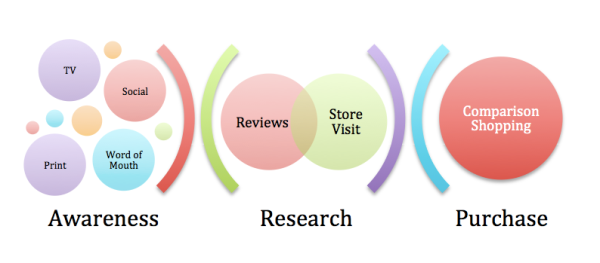Incentivizing The Omni-Channel Marketing Team To Work Together
Ecommerce consumer intent and purchase behavior is a difficult story to capture and even more difficult to understand with disparate data sources telling overlapping stories. Businesses leverage technologies including ad servers, analytics, third-party cookie aggregators, internal-tracking platforms and more… trying to understand what leads to sales. Despite these fancy technologies, more often than not, businesses […]
Ecommerce consumer intent and purchase behavior is a difficult story to capture and even more difficult to understand with disparate data sources telling overlapping stories. Businesses leverage technologies including ad servers, analytics, third-party cookie aggregators, internal-tracking platforms and more… trying to understand what leads to sales.
Despite these fancy technologies, more often than not, businesses resort to a hacked-together Excel report merging various data sets to answer the ultimate question: what’s the bottom line?
Take a step back and it becomes clear that the issue with overlapping data is caused by the conversion land grab and attribution – which department should get credit for a given conversion. Everyone wants credit for every conversion they touch because chances are their compensation depends on it.
What Incentivizes The Search Marketing Team?
Employees are motivated by compensation, yet these financial incentives disincentivize teams with natural cross-over from working together to drive incremental revenue for the business as a whole.
Think about the SEO and Paid Search teams: the business wins when conversions increase, but the SEO team loses when Paid Search aggressively bids on brand-related terms (which you’ll want to do, as studies suggest that incremental conversions will result).
This siloed approach to compensation doesn’t just affect reporting and incentives, it affects the marketing team’s ability to look holistically at how users engage with a site and provide user experiences that are more likely to yield conversions. So what can we do differently to drive revenue and align team incentives?
Looking At The Consumer Buy Cycle
There’s a natural flow to consumer awareness and engagement with a new product:

Image self created – Benny Blum
The consumer buy cycle can be summarized in three main processes: Awareness, Research, and Purchase. Each step might include a slew of different actions, ranging from website visits to conversations with friends to in-store visits, but it all boils down to the moment of truth all marketers vie to identify: where to buy.
Somewhere along the line, our data points start to tell a story that makes sense. Queries with [cheap ____] or [____ lowest price] indicate a price-conscious shopper, whereas [best warranty _____] or [free return shipping _____] indicate a preference for customer service with less price sensitivity. Intelligent marketing teams know when to bow out of the race for the customer while others stay “all in” and go for the gold, despite their ad value propositions falling short of user preference:

Capitalizing On Consumer Intent
What’s often overlooked is that a business that is already developing engaging content about their products has the ability to know more about user intent earlier in the buy cycle than their competition. Insight into user behavior in the research stage — or better yet, linkage between awareness and research — can identify users gearing up to purchase. This insight gives the marketing team the opportunity to integrate the sales experience into the research experience.
So, how can a marketing team get these insights? Look no further than your colleagues: social marketers, content writers, brand marketers are all spreading the word about your products.
If you have a blog or content section of your ecommerce website, or a partner site which focuses on reviews and news, put those users on remarketing lists and change your ads from “buy, buy, buy” to focus more on the central theme of your brand’s value propositions. Then bring the user back to your site to highlight your sensitivity to their interests and gain their trust.
When it comes down to the decision, a well-orchestrated marketing program will identify qualified visitors and leave a brand imprint, creating customer loyalty and higher lifetime values.
But don’t stop there. Take it even further and write three different articles about the same product set — one covering top-rated, one covering best value, and one covering best customer service.
Create multiple user lists and assign unique values per user based on which article(s) they read. Serve up preference-specific ads to stay top of mind while the user makes their way down the funnel. There might be added advertising costs up front, but increased conversion rates and higher lifetime values justify the investment.
Incentivizing Team Collaboration
It’s time to erase the blurry lines between outreach and direct response by creating collective goals. Incentivize collaboration among teams that have natural and seamless common interests. Leverage multiple attribution models to understand cross channel interactions and compensate the team as a team.
Contributing authors are invited to create content for MarTech and are chosen for their expertise and contribution to the search community. Our contributors work under the oversight of the editorial staff and contributions are checked for quality and relevance to our readers. MarTech is owned by Semrush. Contributor was not asked to make any direct or indirect mentions of Semrush. The opinions they express are their own.
Related stories
New on MarTech